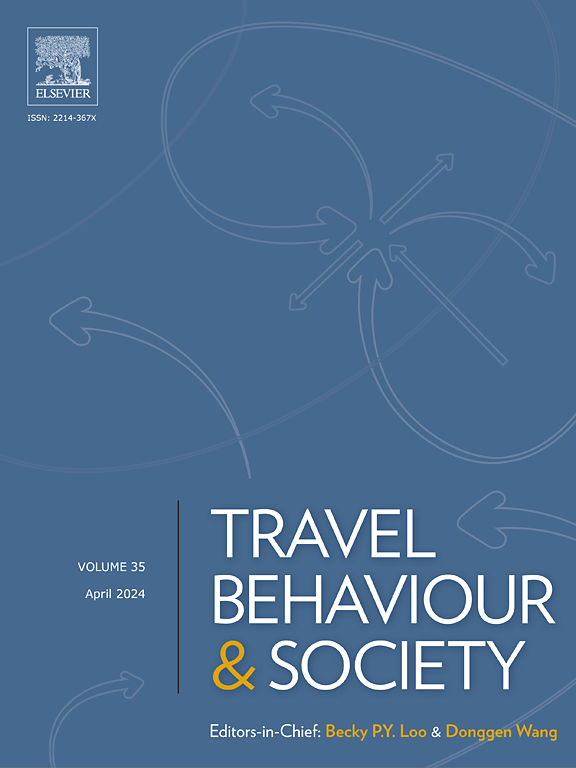Green stormwater infrastructure and active mobility: A case study investigating the effects of bioswales on individuals’ perceptions
IF 5.7
2区 工程技术
Q1 TRANSPORTATION
引用次数: 0
Abstract
Cities are increasingly designing streets with green stormwater infrastructure (GSI) to improve urban drainage systems, while providing secondary socio-environmental benefits. Yet, the relationship between GSI and active mobility remains underexplored. This study addresses this gap by conducting a case study analyzing the impact of GSI implementation on individuals’ perceptions of walking and cycling infrastructure, while identifying associated challenges and opportunities. The case study focuses on the redesign of five residential streets with bioswales in a small Canadian city. Data were collected through: (i) an online and in-person survey with 296 residents, (ii) interviews with 12 municipal stakeholders, residents, or workers, and (iii) two focus groups with children aged 10–11.
Findings indicate that implementing bioswales within the right-of-way contributes to enhanced satisfaction with street design for walking and cycling. Bioswales have the potential to improve the comfort and safety of active travellers by reallocating space for pedestrians and cyclists, while segregating non-motorized and motorized traffic. However, satisfaction with bioswales varies significantly among individuals, following personal characteristics and attitudes. Factors such as exhibiting eco-friendly behaviour, valuing the aesthetics of the neighbourhood, and recognizing the socio-environmental and active mobility benefits of bioswales positively contribute to satisfaction. Conversely, limiting factors stem from changes experienced by car drivers due to the new street configuration and limited agreement or awareness regarding the socio-environmental benefits they provide.
This paper is relevant to planners and researchers wishing to understand the challenges and opportunities associated with designing multifunctional streets to support sustainable urban drainage systems and active mobility.
绿色雨水基础设施和积极的流动性:一个调查生物威尔士对个人认知影响的案例研究
城市越来越多地设计带有绿色雨水基础设施(GSI)的街道,以改善城市排水系统,同时提供次要的社会环境效益。然而,GSI与主动迁移率之间的关系仍未得到充分探讨。本研究通过案例研究分析GSI实施对个人对步行和骑自行车基础设施的看法的影响,同时确定相关的挑战和机遇,解决了这一差距。该案例研究的重点是加拿大一个小城市的五个住宅街道的生物威尔士的重新设计。数据通过以下方式收集:(i)对296名居民进行在线和面对面调查,(ii)对12名市政利益相关者、居民或工人进行访谈,以及(iii)两个10-11岁儿童的焦点小组。研究结果表明,在路权范围内实施生物威尔士有助于提高人们对步行和骑自行车的街道设计的满意度。通过重新分配行人和骑自行车者的空间,同时隔离非机动交通和机动交通,生物威尔士有可能改善活跃旅行者的舒适度和安全性。然而,由于个人的特点和态度,对生物威尔士的满意度在个体之间存在显著差异。表现出生态友好的行为、重视邻里的美学、认识到生物威尔士的社会环境和积极的流动性好处等因素对满意度有积极的贡献。相反,限制因素源于汽车驾驶员由于新的街道配置和对其提供的社会环境效益的有限协议或意识而经历的变化。本文旨在帮助规划者和研究人员了解与设计多功能街道相关的挑战和机遇,以支持可持续城市排水系统和主动交通。
本文章由计算机程序翻译,如有差异,请以英文原文为准。
求助全文
约1分钟内获得全文
求助全文
来源期刊

Travel Behaviour and Society
TRANSPORTATION-
CiteScore
9.80
自引率
7.70%
发文量
109
期刊介绍:
Travel Behaviour and Society is an interdisciplinary journal publishing high-quality original papers which report leading edge research in theories, methodologies and applications concerning transportation issues and challenges which involve the social and spatial dimensions. In particular, it provides a discussion forum for major research in travel behaviour, transportation infrastructure, transportation and environmental issues, mobility and social sustainability, transportation geographic information systems (TGIS), transportation and quality of life, transportation data collection and analysis, etc.
 求助内容:
求助内容: 应助结果提醒方式:
应助结果提醒方式:


